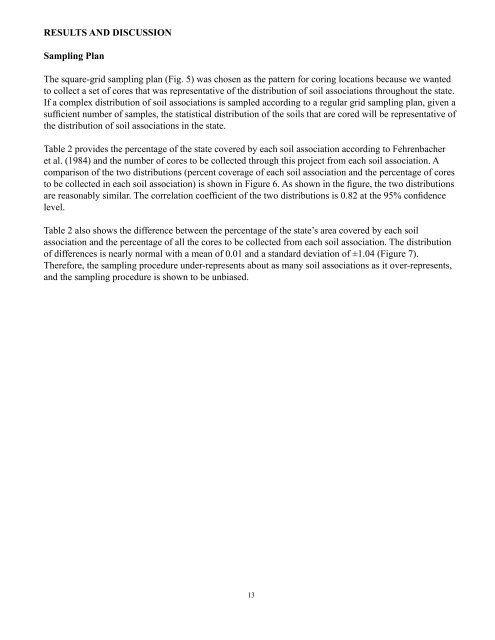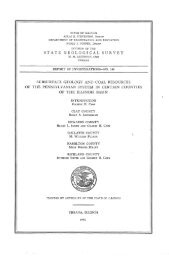Cores 11 through 26 by Gary B. Dr - University of Illinois at Urbana ...
Cores 11 through 26 by Gary B. Dr - University of Illinois at Urbana ...
Cores 11 through 26 by Gary B. Dr - University of Illinois at Urbana ...
Create successful ePaper yourself
Turn your PDF publications into a flip-book with our unique Google optimized e-Paper software.
RESULTS AND DISCUSSIONSampling PlanThe square-grid sampling plan (Fig. 5) was chosen as the p<strong>at</strong>tern for coring loc<strong>at</strong>ions because we wantedto collect a set <strong>of</strong> cores th<strong>at</strong> was represent<strong>at</strong>ive <strong>of</strong> the distribution <strong>of</strong> soil associ<strong>at</strong>ions <strong>through</strong>out the st<strong>at</strong>e.If a complex distribution <strong>of</strong> soil associ<strong>at</strong>ions is sampled according to a regular grid sampling plan, given asufficient number <strong>of</strong> samples, the st<strong>at</strong>istical distribution <strong>of</strong> the soils th<strong>at</strong> are cored will be represent<strong>at</strong>ive <strong>of</strong>the distribution <strong>of</strong> soil associ<strong>at</strong>ions in the st<strong>at</strong>e.Table 2 provides the percentage <strong>of</strong> the st<strong>at</strong>e covered <strong>by</strong> each soil associ<strong>at</strong>ion according to Fehrenbacheret al. (1984) and the number <strong>of</strong> cores to be collected <strong>through</strong> this project from each soil associ<strong>at</strong>ion. Acomparison <strong>of</strong> the two distributions (percent coverage <strong>of</strong> each soil associ<strong>at</strong>ion and the percentage <strong>of</strong> coresto be collected in each soil associ<strong>at</strong>ion) is shown in Figure 6. As shown in the figure, the two distributionsare reasonably similar. The correl<strong>at</strong>ion coefficient <strong>of</strong> the two distributions is 0.82 <strong>at</strong> the 95% confidencelevel.Table 2 also shows the difference between the percentage <strong>of</strong> the st<strong>at</strong>e’s area covered <strong>by</strong> each soilassoci<strong>at</strong>ion and the percentage <strong>of</strong> all the cores to be collected from each soil associ<strong>at</strong>ion. The distribution<strong>of</strong> differences is nearly normal with a mean <strong>of</strong> 0.01 and a standard devi<strong>at</strong>ion <strong>of</strong> ±1.04 (Figure 7).Therefore, the sampling procedure under-represents about as many soil associ<strong>at</strong>ions as it over-represents,and the sampling procedure is shown to be unbiased.13
















